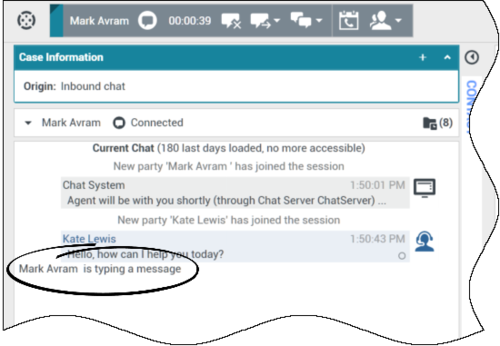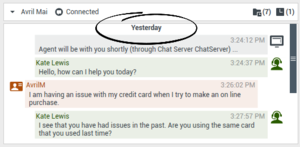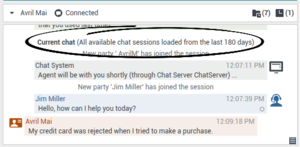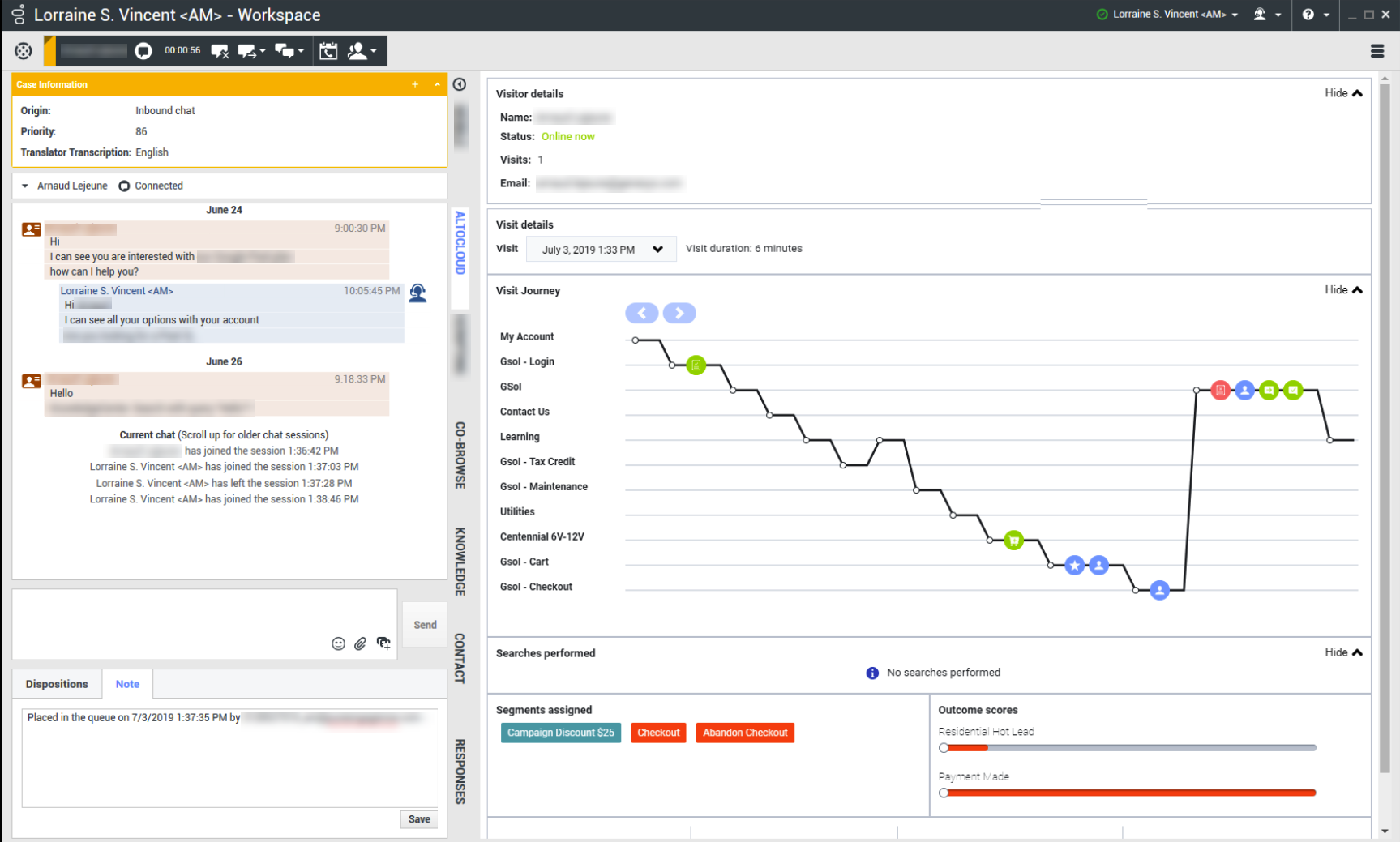Contents
- 1 Chat Interaction
- 1.1 The Chat Interaction Window
- 1.2 Handling a Chat Interaction
- 1.3 Chat Transcript Area
- 1.4 Chat Message Area
- 1.5 Pending Response Indicator
- 1.6 Transferring a Chat Session
- 1.7 Conferencing a Chat Session
- 1.8 How do I continue a chat interaction?
- 1.9 Chat Consultation
- 1.10 Transfer to Consultation Target
- 1.11 Conference with Consultation Target
- 1.12 Altocloud Chat Interaction
- 1.13 Related Resources
Chat Interaction
[Modified: 8.5.115.17, 8.5.113.11, 8.5.111.21, 8.5.117.18, 8.5.121.03, 8.5.122.08, 8.5.128.07]
Chat is real-time two-way communication between you and your contact through your computer.
Use the Zoom control in the Main Menu (refer to Manage your settings and preferences) to change the size of the text in this view. This feature might not be available in your environment. [Added: 8.5.109.16]
Chat tasks enable you to handle chat interactions with contacts and internal targets. Click the links below to learn more:
- Chat Interaction: Enables you to view all of the information that is necessary to handle a chat interaction with a contact.
- Chat Consultation: Enables you to consult with another agent about the current chat interaction. Chat consultations that are started from an active interaction enable your internal target to view case data, contact information, and history, as well as the live transcript of the communication with the external contact. The target agent can choose not to accept your consultation request. You can also transfer or conference your call from an Active Consultation to the consultation target.
- Altocloud Chat Interaction: Enables you to view the details of a contact's visit to your company website before and after they initiated a web chat interaction. This usually happens when your contact clicks a web chat widget, requests a quote, or requests more information.
In the event that there is a problem in your contact center and connection to the servers that handle your interactions is lost, some functionality might be temporarily not available or you might lose the interaction with your contact. Workspace displays system messages that inform you about the status of each of your available media channels.
The Chat Interaction Window
During a chat session, your contact enters text in a chat interface, usually on your company's website, and the text that he or she enters is displayed in the Workspace Chat interaction view. The text that your contact types appears both on your chat window and on your contact's chat window.
You can read the text that your contact sends to you, and you can respond to the contact by typing in the chat text area and clicking Send to send what you type to the chat interface that the contact is using. You might see a small circle in the bottom right of your message in the transcript. When the circle disappears, you know that your message has been read by the contact.
![]()
The Workspace Chat interaction interface maintains the transcript (a scrolling list of the written correspondence between you and your contact) of the chat — it might also include chat from other people in your company if you conference the chat or if the chat session is transferred to you.
When your contact is typing in their chat interface, a small notice appears next to the contact's name in the chat transcript to notify you that they are typing. Your system might be configured to let you see what the contact is entering before they send it (see the following figure).
Be careful not to respond to what the contact is typing before they have sent it to you!
Why is the Chat Interaction bar flashing?
[Added: 8.5.113.11]
While your are handling a chat interaction, sometimes you change your focus to another interaction, such as a chat with a different contact, a phone call, or an email, or you might start using another application and its windows block the Workspace windows.
In these situations you might notice that the Chat Interaction bar in the Interaction Bar begins to flash yellow and that the Workspace icon in the task bar also flashes yellow.
This flashing notifies you that something has changed. Here are some of the reasons that the chat interaction might flash in the Interaction Bar:
- The pending response has reached the warning stage.
- Another agent has joined or left the chat (such as your supervisor or someone involved in a consultation).
- The contact has left the chat.
- The chat session is about to timeout due to inactivity by you and your contact.
- The chat session has timed out due to inactivity by you and your contact.
- The chat session is about to close because the contact has disconnected. Your administrator might specify that chat inteactions close automatically after a contact disconnects. They might also specify a timer before the chat closes to let you finish after call work. Once a chat closes, you cannot add a disposition or a note. [Added: 8.5.128.07]
Chat Interaction Window Actions
The Chat Interaction window enables you to handle many chat-related tasks, which include the following:
- Send a response to the contact.
- View an indicator (
 ) that enables you to determine when a response from you is pending.
) that enables you to determine when a response from you is pending. - Push one or more URLs to your contact (open web pages automatically on the contact's desktop).
- Receive files and images from your contact. [Added: 8.5.115.17]
- Transfer files and images to your contact. [Added: 8.5.115.17]
- (
 ) Instant-transfer the chat.
) Instant-transfer the chat. - (
 ) Instant-conference the chat.
) Instant-conference the chat. - Select Mark Done for the current interaction.
- Set a disposition code.
- Use the Note to attach a note to the interaction history.
- View Case Data (attached data) for the current interaction.
- Start a consultation:
- Call the sender, if there is a phone number in the contact database. You can also click a phone number in the Chat transcript to launch a call.
- Email the sender, if there is an email address in the contact database. You can also click an email address in the Chat transcript to launch an email message.
- Schedule a Callback—Click Schedule Callback (
 ) to open the New Callback dialog box. See Genesys Callback. [Added: 8.5.111.21]
) to open the New Callback dialog box. See Genesys Callback. [Added: 8.5.111.21] - Blend the interaction with other media (such as email, voice, and SMS) by using the Party Action menu.
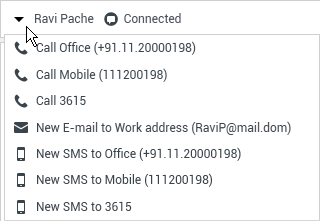
- View and manage contact history.
- View and manage contact information. Your account might be configured to let you assign an interaction with an unknown contact to a known contact in the contact database by using the Manual Contact Assignment feature [Modified: 8.5.117.18].
- Hide or display the controls and information about the current interaction by clicking the collapse/expand Interaction View button: {
Handling a Chat Interaction
The name of the contact and the elapsed time of the interaction are displayed at the top.
Connection-status information is displayed next to the contact drop-down menu. Use the contact drop-down menu to call the contact if the contact's phone number is available from your contact database.
If there are in-progress or recent interactions for the current contact, the number of interactions is displayed beside the connection status of the interaction.
The Chat toolbar is above the Chat Transcript area. Use the Chat toolbar to do the following:
- End Chat—Click End Chat (
 ) to stop the current chat interaction.
) to stop the current chat interaction. - Instant Chat Transfer—Click Instant Chat Transfer (
 ) to redirect (transfer) the current chat interaction to an internal target by using the Team Communicator.
) to redirect (transfer) the current chat interaction to an internal target by using the Team Communicator. - Instant Chat Conference—Click Instant Chat Conference (
 ) to share (conference) the current chat interaction with an internal target by using the Team Communicator. To conference with an agent group, a skill, or an interaction queue, enter the name of the skill, group, or queue, and an available agent with that skill or in that group or queue is notified of your conference request.
) to share (conference) the current chat interaction with an internal target by using the Team Communicator. To conference with an agent group, a skill, or an interaction queue, enter the name of the skill, group, or queue, and an available agent with that skill or in that group or queue is notified of your conference request. - Consultation—Click Start Consultation (
 ) to start an IM, voice, or chat consultation with an internal target or a contact by using the Team Communicator. To consult with an agent group, a skill, or an interaction queue, choose the name of the skill, group, or queue, and an available agent with that skill or in that group or queue is notified of your consultation request.
) to start an IM, voice, or chat consultation with an internal target or a contact by using the Team Communicator. To consult with an agent group, a skill, or an interaction queue, choose the name of the skill, group, or queue, and an available agent with that skill or in that group or queue is notified of your consultation request.
- Mark Done—Complete a chat session and close the Chat Interaction window by clicking Mark Done (
 ) for the current interaction. You might be configured to specify a disposition code before you can click Mark Done. The Mark Done button is displayed after the Chat interaction is ended.
) for the current interaction. You might be configured to specify a disposition code before you can click Mark Done. The Mark Done button is displayed after the Chat interaction is ended.
Chat Transcript Area
Your account might be configured to have a nickname (pseudonym) displayed as your participant name instead of your real name or your user name. A nickname might be a generic name for all agents in your group, or it might be a unique identifier for you. If you are configured to have a nickname, your nickname is displayed to the contact in the contact's chat transcript and in your chat transcript.
After a certain period of inactivity, your chat session might timeout and the interaction will be ended by the system. Messages about the timeout are displayed in the transcript area and might be saved as part of the chat in the interaction history. [Added: 8.5.115.17]
Chat History
[Added: 8.5.122.08]
Sometimes while you are chatting with a contact, you want to view earlier chat interactions with the contact, particularly if you are working on an ongoing issue with the contact. For example, sometimes a contact might disconnect from a chat interaction because the chat timed out or they lost connection on their device before the session was complete. When they reconnect, it is important to have the earlier session for reference so that you do not ask for information that they have already provided.
You can access the entire history of interactions with a contact by clicking the History tab in the Contact Information and History view of the interaction window.
Your account might be configured so that older chat interactions with the contact are displayed, in chronological order, directly above the current chat interaction. If your account is set up for this feature, in the transcript you will see text above the current chat session indicating where the current chat begins and a message informing you that to see older chat sessions you must scroll up. It might take a few seconds for older chat sessions to load and be displayed in the chat transcript.
When you scroll up, each older chat session is divided by a day, for example Yesterday or November 29, to make it easier for you to find a specific session.
Once all the older chat sessions have loaded a notice is displayed informing you from how long ago older chat sessions are available.
URLs and Security
[Added: 8.5.121.03] Sometimes URLs (links to websites) are sent to you by a contact. URLs in the Chat transcript are always displayed as the actual address. Contacts cannot send you a disguised URL in an attempt to direct you to a malicious website. You will be able to read the URL before clicking on it. If you hover your mouse pointer over the URL, a tooltip is displayed that lets you see the address.
Receive Files from Contacts
[Added: 8.5.115.17]
Your account might be set up to let you receive files, including PDFs, .doc, images, and other types, from your contact as an attachment to the chat interaction.
The received file is displayed as a thumbnail or as an icon that corresponds to the file type in the chat transcript.
Double-click a file icon to open it. If you click the save button you might be able to save the file to your workstation or network.
Right-click the thumbnail/icon to display a menu is that might allow you to open, save, or print the file. If more than one file has been transferred, you have the opportunity to save the one that you clicked, or save all (including the files that you transferred). If the file is displayed as an icon instead of a thumbnail, you can also select the icon then press Space to download it.
If there is a problem with the transferred file, you will see the following icon and tooltip. You might have to ask the sender to verify that they sent the correct file and then ask him or her to resend it.
Chat Message Area
The Chat Message entry area enables you to perform the following actions:
- Type text.
- Paste, copy, and select text by using the context menu.
- Insert and push a URL.
- View the standard response library, and insert a response in the email interaction, or automatically insert a response by typing a pre-defined shortcut keyword.
- Verify the spelling of the content of your message.
- If you try to send a message that contains misspelled world, your system might be configured to display a warning dialog box that asks you to confirm that you want to send the message without correcting the potential misspelled words. Click Yes to send the message anyway, or click No to return to the message and correct the misspelled words. [Added: 8.5.105.12]
Send Emojis to Contacts
[Added: 8.5.115.17]
Your account might be set up to let you send emojis (emoticons or smileys) to your contact as part of the chat interaction text. Emojis are little faces and other symbols that you can use to let your contact know how you are feeling or to help them to know when something is good, funny, bad, or sad. Ask your supervisor or administrator about when to use emojis.
To add an emoji to your chat interaction:
- Click the Choose an emoji button (
 ) that appears next to the Send button to display the menu of emojis that you can send.
) that appears next to the Send button to display the menu of emojis that you can send.
- Click an emoji.
- Click Send.
Transfer Files to Contacts
[Added: 8.5.115.17]
Your account might be set up to let you send files, including PDFs, .doc, images, and other types, to your contact as an attachment to the chat interaction.
There are two possible modes that might be enabled for this feature:
- Attach a file from your workstation or network. Click
 Add Attachments to open the Open File window. Click Send to transfer the file. You can also drag a file to the message composition area.
Add Attachments to open the Open File window. Click Send to transfer the file. You can also drag a file to the message composition area. - Attach a file from the Responses tab. Double-click a response that contains an attachment or click Insert Standard Response Text to add the file as an attachment. Click Send to transfer the file.
Before or after you transfer the file, you might have the ability to open, save, save all (including files that have been transferred to you), delete (remove from the list of files to be sent), delete all, or print the file. Click the file name to display the drop-down menu. If the file is displayed as an icon instead of a thumbnail, you can also select the icon and then press Space to download it.
If there is a problem with the transferred file, you will see the following icon and tooltip. Check that you sent the correct file and then resend it.
Push a URL to a Contact
[Modified: 8.5.115.17]
Click the Show the Push URL area button (![]() ) that appears next to the Send button to open the Push URL area.
) that appears next to the Send button to open the Push URL area.
Use this area to enter and test a URL before you push (send) it to your contact.
Type or paste a URL in the Push URL Area text field, or select a previously sent URL by selecting it from the drop-down list.
Click Check URL (![]() ) to open the URL in a web browser on your desktop, to verify that the URL is correct.
) to open the URL in a web browser on your desktop, to verify that the URL is correct.
Click Send to push the URL to your contact. The following text and an active URL link are displayed in the Chat Transcript area of the chat window or browser of your contact:
Please navigate to the link: <url>
You can view the history of URLs that you have used by clicking the down arrow in the Push URL field to open a menu from which you can select a previous URL. Alternately, you can start typing a URL that you have used before, and Workspace will auto-suggest URLs in your history that match text you enter.Pending Response Indicator
The pending response indicator is displayed next to the interaction-type icon (![]() ) at the top of the Chat interaction window.
) at the top of the Chat interaction window.
The color of the pending response indicator begins as green. If you have not responded by a specific time interval, the indicator changes to yellow. If you still have not responded by a second time interval, the indicator changes to red and begins to flash.
If you have a pending response, and the Chat Interaction window is not the active window, the Workspace task icon begins to flash in the Windows taskbar, regardless of the condition that is displayed by the pending response indicator.
If you place your mouse pointer over any flashing item, a preview of the interaction is displayed and the flashing stops. The preview displays the latest message from the contact.Transferring a Chat Session
- Click the Instant Chat Transfer (
 ) button. The Team Communicator is displayed.
) button. The Team Communicator is displayed. - Choose a transfer target.
- Select Instant Chat Transfer.
If the target accepts the interaction, the interaction window on your desktop closes.
If the target rejects the interaction, an error message informs you that the target has rejected the interaction.Conferencing a Chat Session
- Click the Instant Chat Conference (
 ) button. The Team Communicator is displayed.
) button. The Team Communicator is displayed. - Choose a conference target.
- Select Instant Chat Conference.
An invitation is sent to the selected target.
If the target accepts the invitation, the target is added to your chat session. The target sees the chat transcript and is able to send messages to you and your contact simultaneously. Anything that you or your contact send during the conference is also displayed to the target. If you end the session, the ownership of the session is transferred to the conference target.
If the target rejects the invitation, a system message is displayed at the top of the Chat Interaction window to inform you that the conference invitation has been rejected.How do I continue a chat interaction?
Some environments have asynchronous chat available. This feature keeps chats open after the last agent leaves the session, and the agent can rejoin the session until the session is marked Done. This video shows you how it works if it is available in your environment.
Chat Consultation
Overview: Starting a Chat Consultation
To invite another party to consult with you about your chat session:
- Click the Start Consultation (
 ) button. The Team Communicator is displayed.
) button. The Team Communicator is displayed. - Choose a consultation target. To consult with an agent group or skill, choose the name of the skill or group, and an available agent with that skill or in that group or interaction queue is notified of your consultation request.
- Select Start Chat Consultation from the Action menu.
An invitation is sent to the target.
If the target accepts the invitation, a new chat interaction with the target is added to your Chat Interaction window, below your first interaction.
If the target rejects the invitation, a system message is displayed at the top of the Chat Interaction window to inform you that the conference invitation has been rejected. - Either you or your target can end the chat consultation. Ending the chat consultation does not end your chat interaction with your contact.
Use the new chat interaction to send chat messages to your target without your contact seeing what you type or what your target responds.
The target sees the chat transcript between you and your contact.
If you click End (![]() ) to end the session with your contact, the session with your consultation target also ends.
) to end the session with your contact, the session with your consultation target also ends.
Both you and your target must click Mark Done (![]() ) to close the interaction.
) to close the interaction.
Note: If you have a pending response, and the Chat Interaction window is not the active window, it begins to flash in the Windows taskbar, regardless of the condition that is displayed by the pending-response indicator.
You can also launch an Instant Messaging (IM) session or voice call with another agent to consult about the chat session.
You can transition your chat, IM, or voice consultation into a transfer to or conference with your consultation target.
The consultation part of a chat interaction is not consider as a standalone interaction in your activity history. It is owned by the original contact interaction, not your history. The consultation part of the transcript of a contact interaction does not show up in the Contact History nor the My History.
My History reports the contact-related interactions where the logged in agent engaged with the contact. Agents who are consulted are not considered as engaged with the contact and as a consequence are not marked as ‘interaction owner’; therefore, this interaction does not show up in the My History of this agent.
For example: contact engaged with Agent1 – Agent1 consults Agent2, you will have:
- 1 New entry in My History of Agent1 – does not contain consultation transcript with Agent2
- No entry in My History of Agent2
Transfer to Consultation Target
- Click the Instant Chat Transfer (
 ) button. The Team Communicator is displayed.
) button. The Team Communicator is displayed. - Under Active Consultations, choose the active consultation target as your transfer target.
- In the Action menu, select Instant Chat Transfer.
Conference with Consultation Target
- Click the Instant Chat Conference (
 ) button. The Team Communicator is displayed.
) button. The Team Communicator is displayed. - Under Active Consultations, choose the active consultation target as your conference target.
- In the Action menu, select Instant Chat Conference.
The consultation target is added to your chat interaction. The Chat Interaction window displays the entire transcript of the chat session between you and the contact.
You, the contact, and the consultation target can each see the messages that are sent by the others.
If the conference target does not accept your request, the conference request is released.
During the chat conference, you can perform the following actions:
- In the Action menu next to the name of the connected party, you can choose Delete From Conference to remove the party from the conference.
- Click End (
 ) to end the session with your contact—the session between your consultation target and the contact continues.
) to end the session with your contact—the session between your consultation target and the contact continues.
Altocloud Chat Interaction
If you are set up to use the Genesys Altocloud plugin you will see the Altocloud tab on the right side of the Chat interaction window.
Use the Altocloud tab to view the details of a contact's visit to your company website before and after they initiated a web chat interaction. This usually happens when your contact clicks a web chat widget, requests a quote, or requests more information.
The Genesys Altocloud Agent's Guide contains all the information that you, as an agent, need to understand and use the contents of the Altocloud tab.
Get Started
Using the Altocloud tab
Related Resources
The Workspace Desktop Edition User's Guide (English only) provides detailed lessons for using all the features of Workspace. You might find the following lessons useful:
- Handle A Chat Interaction
- Handle A Chat Consultation
- Transfer A Chat Interaction
- Conference A Chat Interaction
- Handle an Altocloud Chat Interaction
- Blend Different Media Into A Single Conversation
- Main Window Basics
- Workspace Windows and Views
Related topics
- Genesys Altocloud
- Functionality Overview
- Components, Features, and Controls
- Workspace Desktop Edition Help


